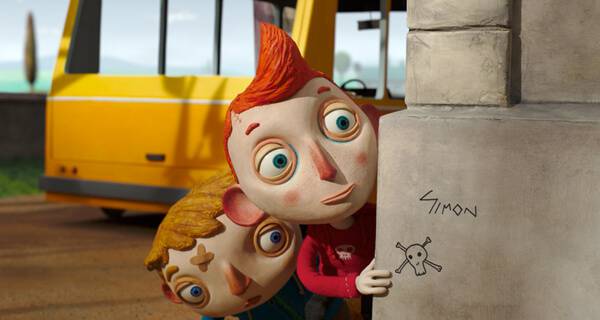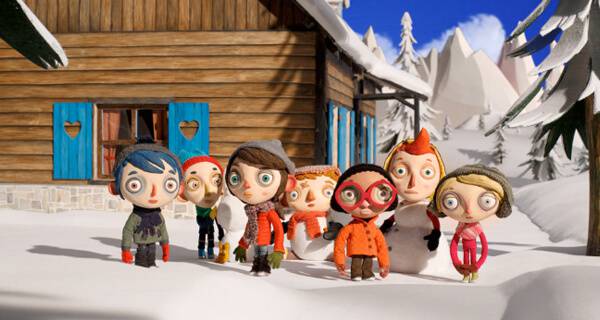‘My Life as a Courgette’ – Film Review
Perhaps the least surprising outcome of this year’s Annecy International Animated Film Festival awards ceremony came in the form of a double-win for My Life as a Courgette (AKA My Life as a Zucchini, depending on where you catch it), the first feature-length endeavor from long-established Swiss-born stop-mo maestro Claude Barras. The director’s impressive short-form filmography includes work for the National Film Board of Canada (2007’s Sainte Barbe, and 2009’s Land of the Heads, co-directed with Cédric Louis), the Swiss collaboration Animatou (2007) and, most recently, Chambre 69 (2012). A standout component of all of his work to date has been a particularly striking and appealing approach to character design that manages to pull off a contemporary, mainstream accessibility while retaining the rough edges and personality of independent artistry.
The aforementioned non-surprise stems not from the usual incarnation of festival ‘buzz’ (something that festivalgoers can get carried along with, not quite able to express precisely why) as much as a sincere emotional response most Annecy attendees were keen to share the moment they left their screenings. Courgette is an enchanting revelation of a film; in trailers, programme listings and promotional materials it appears aesthetically alluring, yet unassuming and low-key. Its visual appeal, however, is matched with a story that is not merely charming kids’ fare, but genuinely witty and emotionally mature.
The opening sequence of the film pulls no punches, introducing us to the timid Icare (clinging throughout the film to his nickname, Courgette) who yearns for the return of his long-absent father while living in fear of his alcoholic single mother. After accidentally killing her, an incident referred to throughout the film with poignant detachedness, we follow the recently-orphaned Courgette as he passes through the system into foster care. There he is forced to acclimate to new surroundings and his fellow intakes, made up of children orphaned under similarly unfortunate circumstances or rescued from neglectful, abusive environments.

The transitional period, in which the intimidating and unfamiliar slowly becomes a comfortable, livable reality, is depicted with tremendous accuracy. Courgette’s arrival is initially met by hostility from the other children, in particular their self-appointed leader Simon who is often the most frustrated by his circumstances and surroundings. As allegiances and mutual respect begin to develop, the guardedness of Courgette’s fellow misfits melts away to reveal an incredibly endearing, idiosyncratic group whose bonds among one another are all the stronger for the absence of a traditional family unit. Thus is revealed the true heart of the film, that of the nature of family itself and the trust, love, loyalty and support that defines it.
https://www.youtube.com/watch?v=qEQLd6o49PM
While Claude Barras’s directorial efforts are doubtless a huge component of the film’s appeal and success, the strength of Céline Sciamma’s screenplay deserves no small amount of recognition. The dialogue is expertly observed and beautifully performed, from the conversations among the children attempting to grasp greater adult concepts that most of us will surely remember from our own youth, to the interactions between children and adults, both well-intentioned (such as the foster home’s staff and police officer Raymond, who feels a sense of obligation to Courgette’s well-being having processed him) and self-serving (new intake Camille’s aunt, who sees the opportunity of caring for her niece as easy-money from the government). While we follow Courgette’s journey from the start, it is Camille who introduces the closest approximation of stability to their environment, effectively dethroning Simon and ending his not-especially-tyrannical rule over the others, while bringing the more introverted children out of their shells. Especially refreshing is the film’s eschewing of a traditional animated feature structure – the predictable character arcs, fallings-out and reconciliations are absent, as is the impulse to indulge a story-light visual spectacle for the final act, presumably down to Sciamma’s faithfulness in adapting the source text Autobiographie d’une courgette by Gilles Paris.

In truth, the obstacles the children are faced with are fairly mundane, their personal dramas distinctly non-cinematic, yet we as an audience are completely invested in them. As such the resolution of the primary threat to the childrens’ quasi-harmonious life, that of Camille (with whom Courgette has become besotted) being forced to leave the home, is a fairly simple affair, yet its sense of victory is all the more impactful for it. Beyond these small victories there are no fairytale endings to be had – orphans remain orphaned, abusive and neglectful parents don’t see the error of their ways (although one substory involving a mother who had been deported leads to one of the film’s strongest payoff gags), and the message is powerfully clear – that small victories are often all that some of us have.
One hopes that the film’s recent Annecy success will play some part in securing international distribution in the near future, as the prospect of this film not being seen by as wide an audience as possible (a fate that has befallen many wonderful animated features produced outside the US) would be a crying shame. In the meantime, should the film find its way to a festival near you, be sure to clear your schedules for it.
My Life as a Courgette won the Feature Film Audience Award and Feature Film Cristal at this year’s Annecy Festival. For more info on the film visit ritaproductions.com


